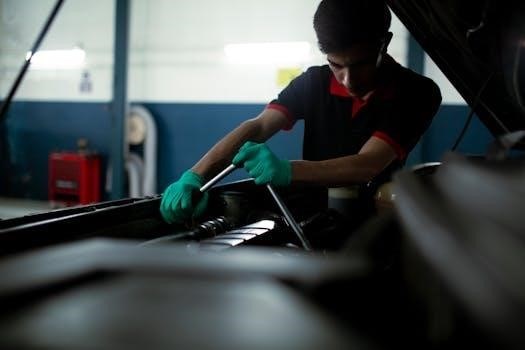Pre-Trip Inspection Checklist PDF⁚ A Comprehensive Guide
This comprehensive guide will navigate the complexities of pre-trip inspections, offering a printable checklist in PDF format․ Mastering this checklist, coupled with training, prepares drivers for CDL exams and ensures vehicle safety before every journey, promoting safer roads and preventing potential hazards․
What is a Pre-Trip Inspection?
A pre-trip inspection is a thorough examination of a commercial vehicle conducted by the driver before operating it on public roads․ This inspection is designed to identify any existing or potential safety defects that could compromise the vehicle’s safe operation․ It encompasses a systematic review of various components, from the engine compartment to the external lights, tires, and brakes․
The primary goal of a pre-trip inspection is to ensure that the vehicle is in safe operating condition and complies with all applicable regulations․ It’s a proactive measure to detect issues early, preventing breakdowns, accidents, and potential violations․ By identifying problems before they escalate, drivers can address them promptly, minimizing downtime and maximizing safety․
This inspection is not merely a formality; it’s a critical responsibility for every commercial driver․ It requires a keen eye for detail, a thorough understanding of vehicle systems, and a commitment to safety․ Failing to conduct a proper pre-trip inspection can have serious consequences, including fines, penalties, and even accidents․
Importance of Pre-Trip Inspections
Pre-trip inspections are paramount for ensuring the safety and reliability of commercial vehicles․ By meticulously examining critical components, drivers can identify potential issues before they escalate into major problems on the road․ This proactive approach significantly reduces the risk of accidents caused by mechanical failures, such as faulty brakes or worn tires․
Beyond safety, pre-trip inspections play a crucial role in maintaining vehicle performance and preventing costly breakdowns․ Early detection of minor issues, such as a loose belt or a leaking hose, allows for timely repairs, avoiding more extensive damage and downtime․ This translates to increased operational efficiency and reduced maintenance expenses over the long run․
Furthermore, adhering to pre-trip inspection protocols demonstrates a commitment to regulatory compliance․ Commercial drivers are legally obligated to conduct these inspections, and failure to do so can result in fines, penalties, and even suspension of driving privileges․ By prioritizing pre-trip inspections, drivers not only protect themselves and others but also uphold their professional responsibilities․
In essence, pre-trip inspections are an indispensable practice for ensuring safety, preventing breakdowns, and maintaining regulatory compliance in the commercial transportation industry․
Legal Requirements for Pre-Trip Inspections (CDL Vehicles)
Commercial drivers operating vehicles requiring a Commercial Driver’s License (CDL) are mandated by law to perform pre-trip inspections․ These regulations, enforced by the Federal Motor Carrier Safety Administration (FMCSA), aim to ensure vehicle safety and prevent accidents stemming from mechanical defects․ Drivers must meticulously inspect various components before each trip, adhering to a standardized checklist․
The inspection must cover critical areas such as the engine compartment, in-cab systems, and external components like lights, tires, and brakes․ Any identified defects that could affect safety must be reported and addressed before operating the vehicle․ Drivers are also required to document the inspection in a written report, detailing any issues found and corrective actions taken․
Failure to comply with pre-trip inspection regulations can result in severe penalties, including fines, citations, and even suspension of CDL privileges․ Moreover, operating a vehicle with known safety defects not only puts the driver at risk but also endangers other motorists on the road․ Therefore, understanding and adhering to these legal requirements is paramount for all CDL holders․
By diligently performing pre-trip inspections and promptly addressing any identified issues, drivers contribute significantly to enhancing road safety and upholding their professional responsibilities․
Components of a Pre-Trip Inspection Checklist
A comprehensive pre-trip inspection checklist encompasses several key areas to ensure vehicle safety and regulatory compliance․ The inspection typically begins with the engine compartment, assessing fluid levels (oil, coolant, transmission), belts, hoses, and wiring for any signs of damage or leaks․ Next, the in-cab inspection involves checking safety items such as the fire extinguisher, warning devices (triangles), spare fuses, and seat belts․
The driver should also verify the proper functioning of gauges, mirrors, and windshield wipers․ Moving to the external vehicle inspection, attention is given to lights (headlights, taillights, brake lights, turn signals), tires (condition, pressure, tread depth), and brakes (air lines, drums/discs, hoses)․ The checklist also includes inspecting the coupling system (if applicable), ensuring secure connections and proper locking mechanisms․
Additional external checks involve examining the fuel tank, steps, drive shafts, air tanks, and battery box for any damage or leaks․ Each component must be thoroughly evaluated to identify potential safety hazards before operating the vehicle․ Documenting all inspection findings, including any defects and corrective actions taken, is crucial for maintaining compliance and promoting a safe driving environment․
This methodical approach ensures that all critical systems are in good working order, minimizing the risk of mechanical failures and accidents on the road․

Engine Compartment Inspection
The engine compartment inspection is a critical aspect of the pre-trip checklist, requiring a meticulous examination of various components to ensure optimal performance and safety․ Begin by checking the engine oil level using the dipstick, ensuring it falls within the safe operating range․ Next, inspect the coolant level in the radiator or coolant reservoir, verifying it is adequate and free from leaks․ Examine the alternator, alternator belts, and associated wiring for secure connections, cracks, fraying, or excessive play․
Pay close attention to the water pump, turbocharger (if equipped), and radiator hoses, looking for any signs of leaks, damage, or deterioration․ Check the oil fill tube for proper sealing and the presence of any leaks around the area․ Inspect the engine air duct work for secure connections and absence of damage that could compromise air intake․

Ensure all components are securely mounted and free from excessive vibration or movement․ Listen for any unusual noises emanating from the engine compartment during startup, which could indicate potential mechanical issues․ Document any findings, noting the condition of each component and any corrective actions needed․ A thorough engine compartment inspection helps prevent breakdowns and ensures the vehicle operates efficiently and safely throughout the trip․
Regular maintenance and attention to detail in this area are essential for prolonging the life of the engine and preventing costly repairs․

In-Cab Inspection
The in-cab inspection is a crucial component of the pre-trip checklist, ensuring that all safety and operational systems within the vehicle are functioning correctly․ Begin by checking essential safety items such as the fire extinguisher, verifying it is properly charged, rated, and securely mounted․ Ensure that you have three reflective triangles, none broken or cracked, and securely stored․
Inspect the fuses, checking for spare fuses and ensuring they are readily accessible․ If the vehicle doesn’t use fuses, note this to the tester․ Next, examine the seat belt for secure mounting, proper latching and unlatching, and smooth adjustment․ Ensure the seatbelt is free from cuts or fraying․
Verify the functionality of all gauges and indicators, including the speedometer, fuel gauge, oil pressure gauge, and temperature gauge․ Test the horn to confirm it is working․ Check the windshield wipers and washers to ensure they provide clear visibility in inclement weather․ Inspect the mirrors for proper adjustment and cleanliness․ Ensure all controls, such as the steering wheel, pedals, and gear shift, operate smoothly and without excessive play․
Finally, perform a brake check to ensure the parking brake and service brakes are functioning correctly․ A thorough in-cab inspection helps identify potential hazards and ensures the driver has full control of the vehicle’s systems․ Regular attention to these details promotes a safe and comfortable driving experience․
External Vehicle Inspection (Lights, Tires, Brakes)
The external vehicle inspection focuses on critical safety components, including lights, tires, and brakes․ Begin by inspecting all lights⁚ headlights (high and low beams), tail lights, brake lights, turn signals, and marker lights․ Ensure they are clean, properly functioning, and free from damage․ Verify that all lights are the correct color and brightness․
Next, conduct a thorough tire inspection․ Check the tire pressure using a gauge and compare it to the recommended pressure listed on the vehicle’s door placard․ Examine the tire tread depth, ensuring it meets the minimum legal requirements․ Look for any signs of damage, such as cuts, bulges, or uneven wear․ Inspect the sidewalls for cracks or abrasions․ Also, check the wheel rims for any signs of damage or deformation․
Finally, assess the braking system․ Inspect the brake lines and hoses for leaks or damage․ Check the brake pads or shoes for wear and thickness; Look for any signs of brake fluid leaks around the calipers or wheel cylinders․ Examine the condition of the rotors or drums, checking for cracks, scoring, or excessive rust․ Ensure that the parking brake engages and disengages properly․ A comprehensive external inspection ensures that the vehicle’s lights, tires, and brakes are in optimal condition for safe operation․
Using a Pre-Trip Inspection Checklist PDF
Effectively using a pre-trip inspection checklist PDF involves a systematic approach to ensure thoroughness and accuracy․ First, download and print the checklist, ensuring you have a physical copy to work with during the inspection․ Before starting, familiarize yourself with each item on the checklist to understand what you’re looking for․
Begin the inspection by following the checklist sequentially, starting with the first item and progressing through each section․ For each item, carefully inspect the corresponding component of the vehicle, comparing its condition to the criteria outlined in the checklist․ If the component meets the requirements, mark it as “OK” or “Pass․” If any issues or defects are found, note them clearly on the checklist, providing specific details about the problem․
Be thorough and meticulous in your inspection, taking your time to examine each component carefully․ Don’t rush through the checklist; instead, focus on identifying any potential safety hazards․ If you’re unsure about the condition of a particular component, consult with a qualified mechanic or supervisor for guidance․
Once you’ve completed the entire checklist, review your findings to identify any necessary repairs or maintenance․ Prioritize addressing any critical safety issues before operating the vehicle․ Finally, retain a copy of the completed checklist for your records, as it may be required for compliance purposes․
Benefits of Using a Pre-Trip Inspection Checklist
Utilizing a pre-trip inspection checklist offers numerous advantages, primarily enhancing safety on the road․ By systematically examining critical vehicle components, potential mechanical issues are identified before they escalate into hazardous situations․ This proactive approach minimizes the risk of accidents caused by equipment failure, protecting both the driver and other road users; A thorough inspection ensures that brakes, lights, tires, and steering systems are functioning optimally, reducing the likelihood of breakdowns or collisions․
Beyond safety, using a checklist contributes to cost savings․ Identifying and addressing minor issues early prevents them from developing into major repairs, which can be expensive and time-consuming․ Regular inspections also extend the lifespan of vehicle components by ensuring they are properly maintained and functioning within specified parameters․
Compliance with regulations is another significant benefit․ Commercial vehicles are subject to strict safety standards, and pre-trip inspections are often mandated by law․ Using a checklist ensures that drivers meet these requirements, avoiding potential fines or penalties․ Furthermore, a well-documented inspection process demonstrates a commitment to safety, enhancing the company’s reputation and reducing liability in case of accidents․
Finally, checklists promote efficiency by streamlining the inspection process․ They provide a standardized framework, ensuring that all critical areas are covered consistently․ This saves time and reduces the risk of overlooking important details, leading to a more thorough and effective inspection overall․
Where to Find Pre-Trip Inspection Checklist PDFs
Locating reliable pre-trip inspection checklist PDFs is easier than ever, thanks to the wealth of resources available online․ Official government transportation websites, such as those maintained by the Department of Transportation (DOT) in various states, often provide downloadable checklists tailored to specific vehicle types and regulatory requirements․ These checklists are invaluable for ensuring compliance with local and federal laws․

Commercial driver’s license (CDL) training schools and trucking associations are another excellent source․ They frequently offer free or low-cost resources to assist drivers in preparing for inspections and maintaining vehicle safety․ These organizations often provide detailed checklists that incorporate industry best practices․
Many reputable trucking and transportation companies also develop their own checklists, which are often customized to address the unique needs of their fleets․ These checklists may be available on their websites or through internal training programs․ Consulting with experienced mechanics or fleet managers can provide valuable insights into the most effective checklist for a particular operation․
Finally, online forums and communities dedicated to trucking and commercial driving can be a great source of information․ Members often share their own checklists, tips, and experiences related to pre-trip inspections․ However, it’s essential to verify the accuracy and completeness of any checklist obtained from these sources before relying on it․
By utilizing these diverse resources, drivers and fleet managers can access a wide range of pre-trip inspection checklist PDFs to ensure vehicle safety and regulatory compliance․
